
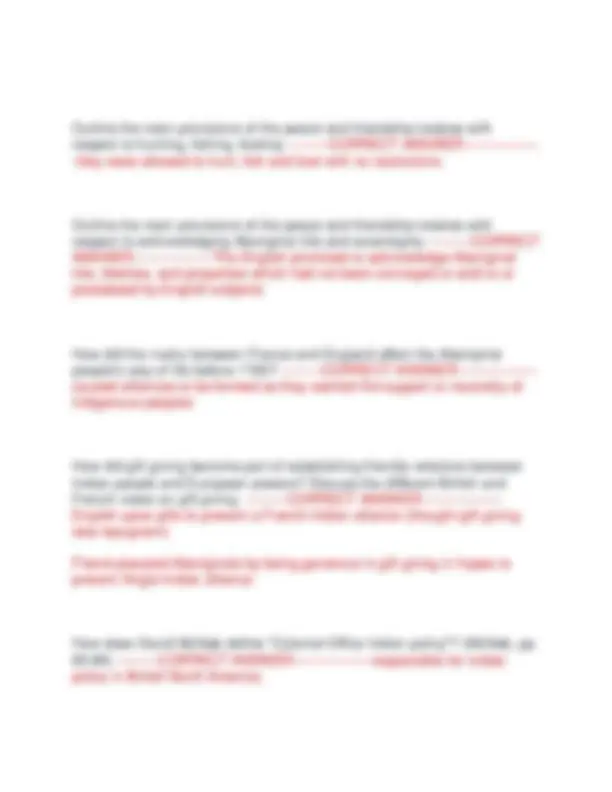
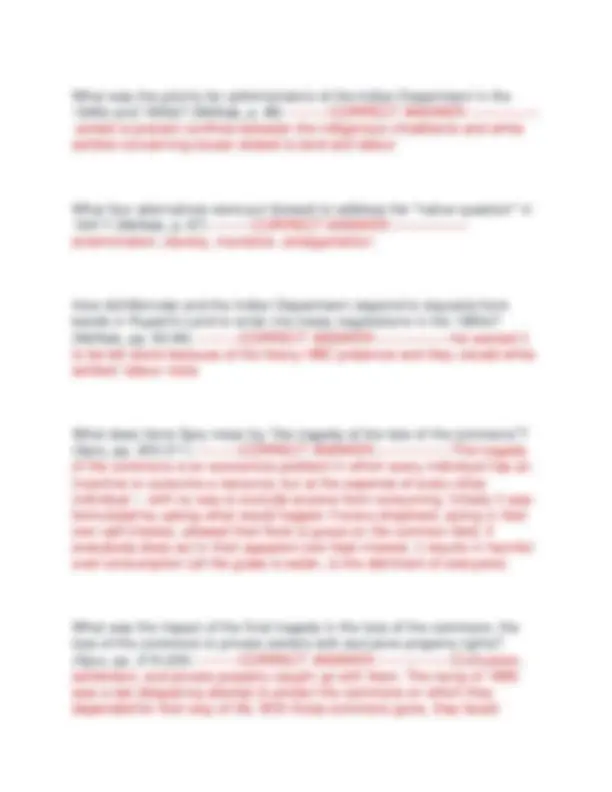
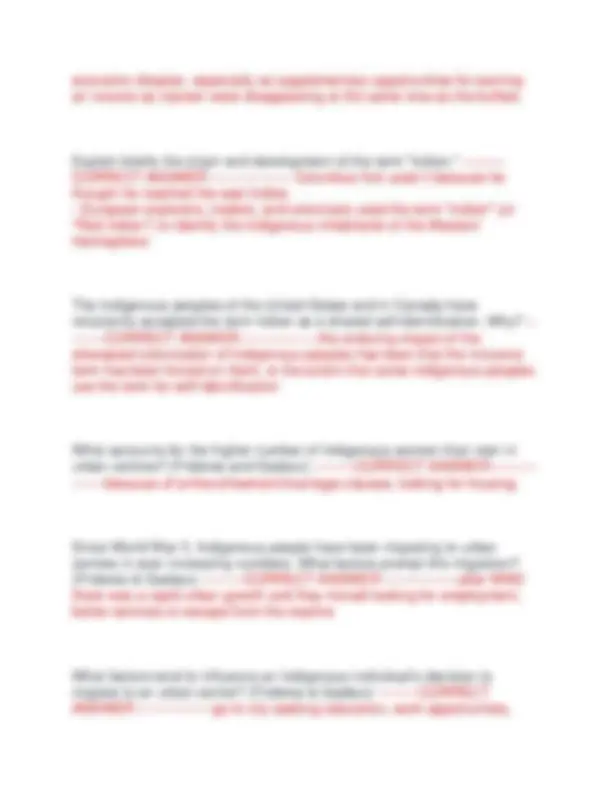
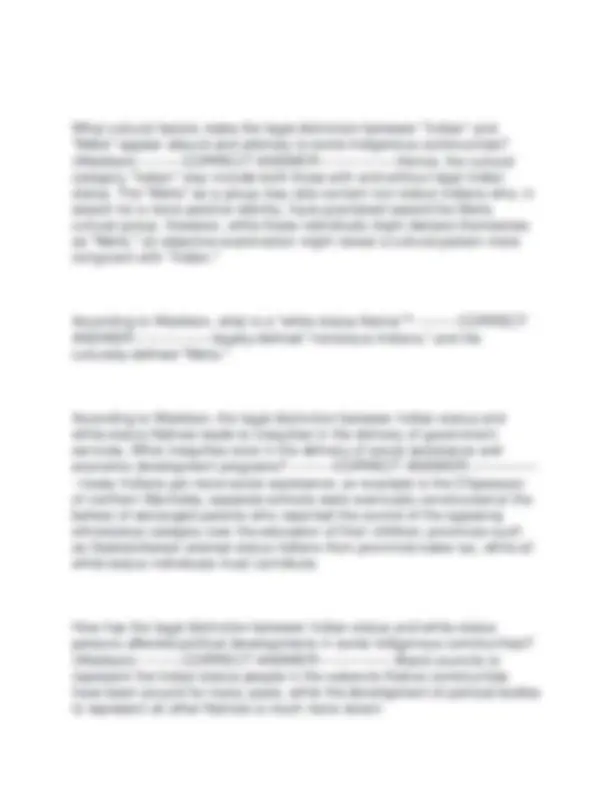
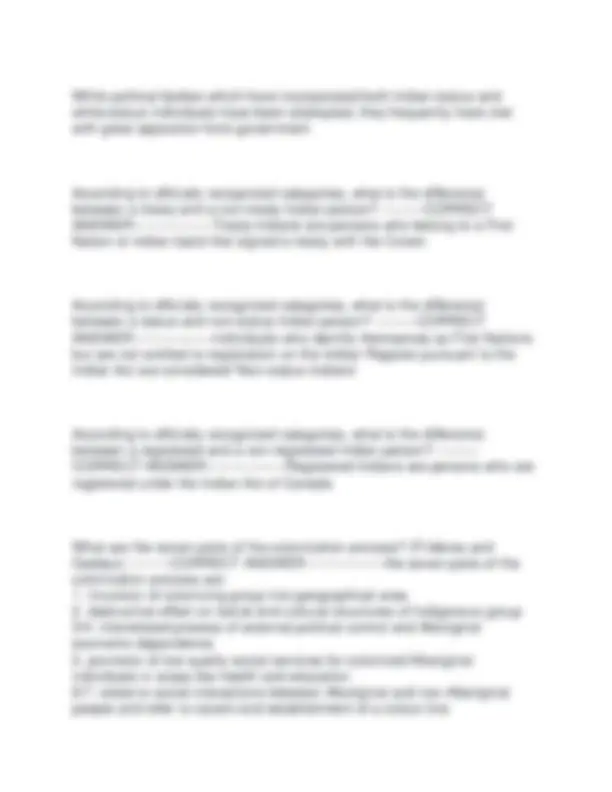
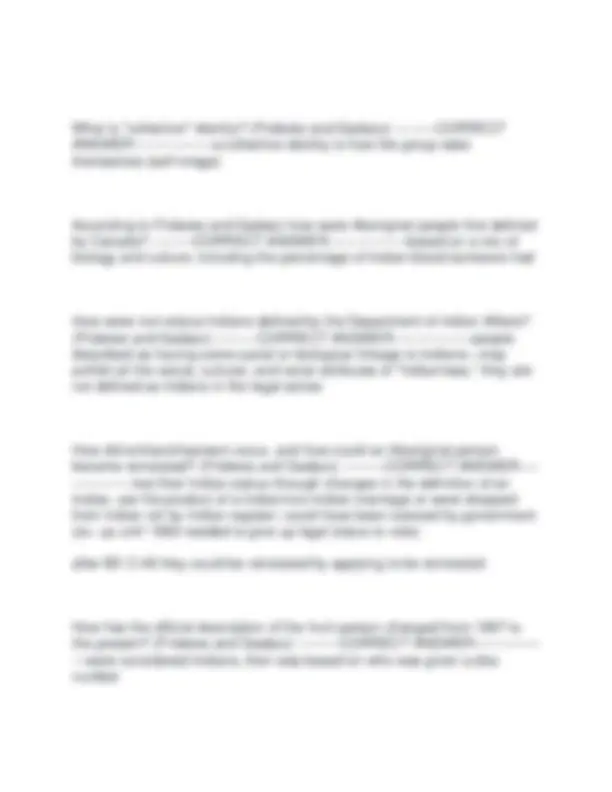
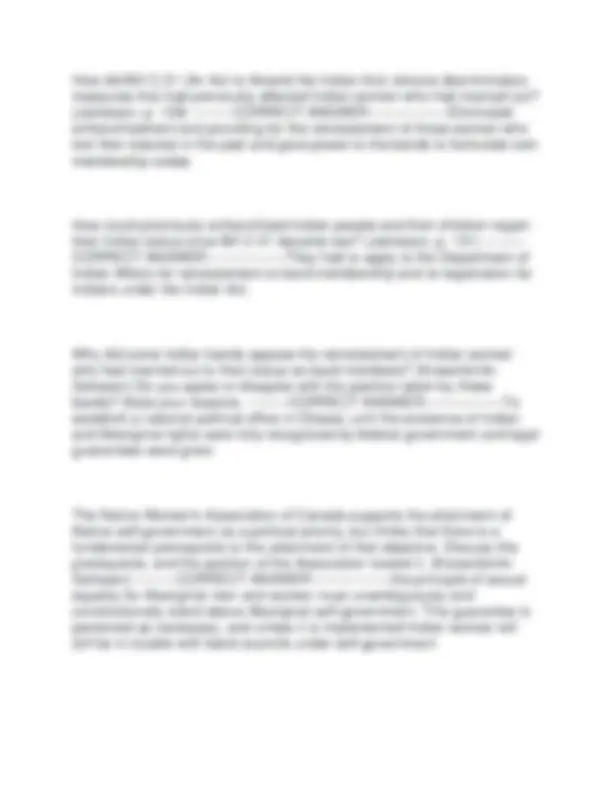
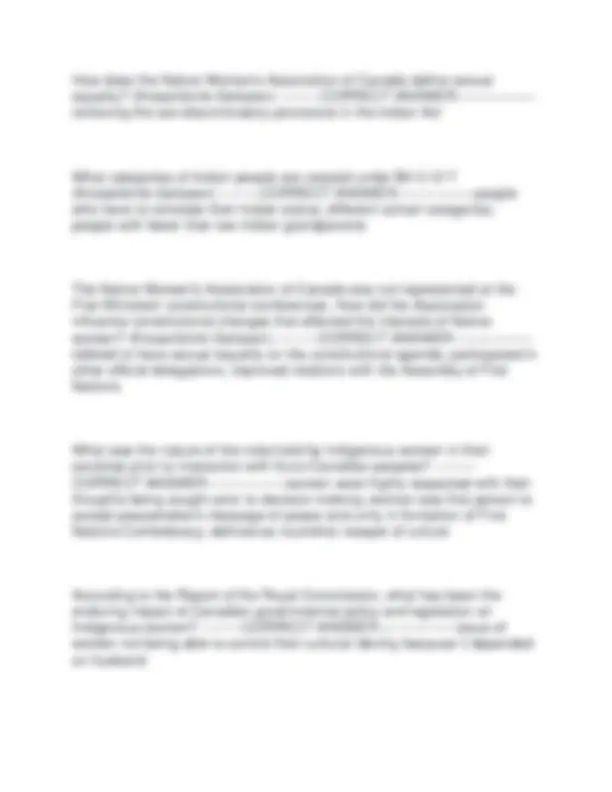
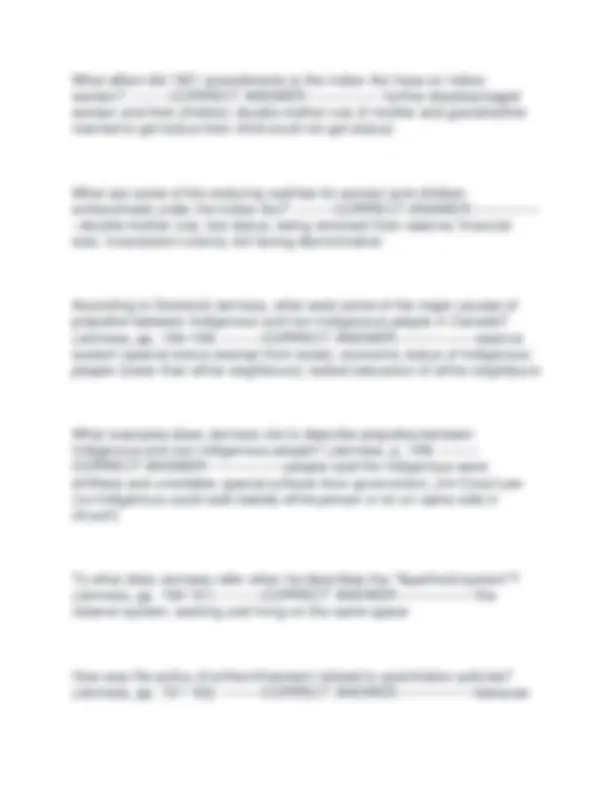
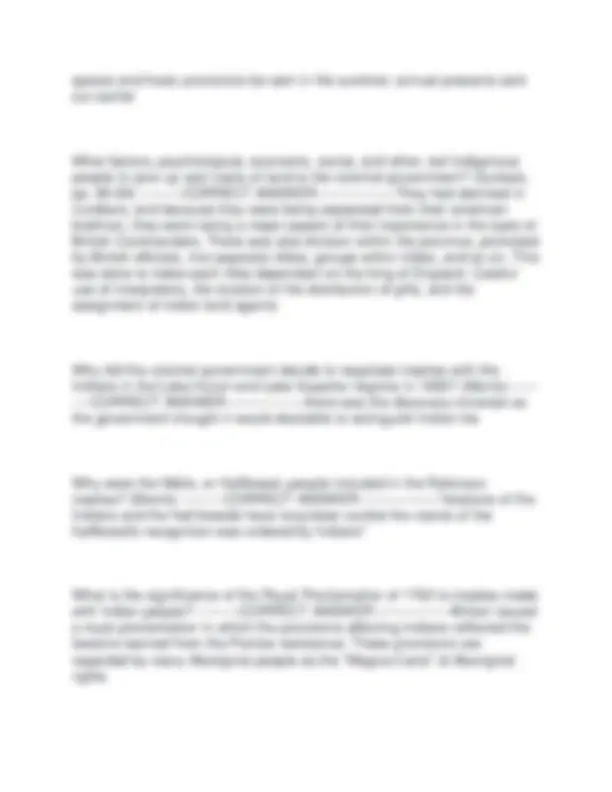
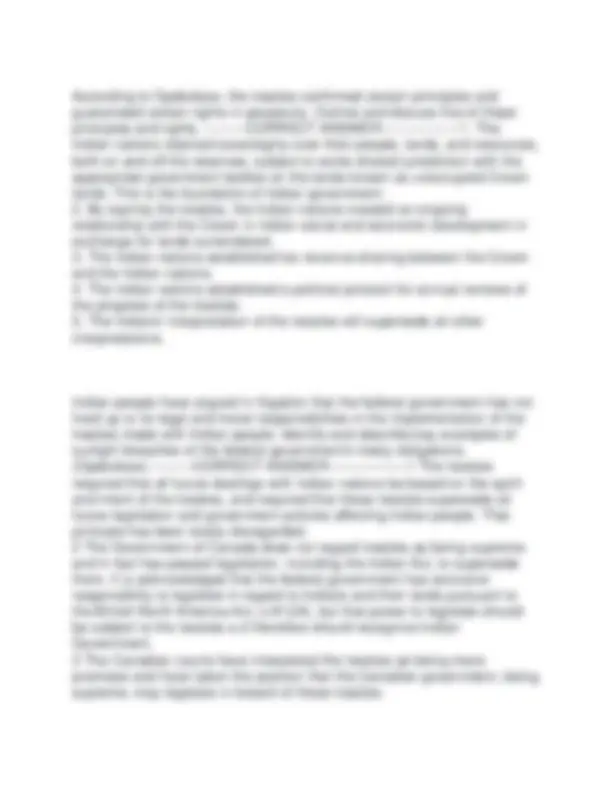
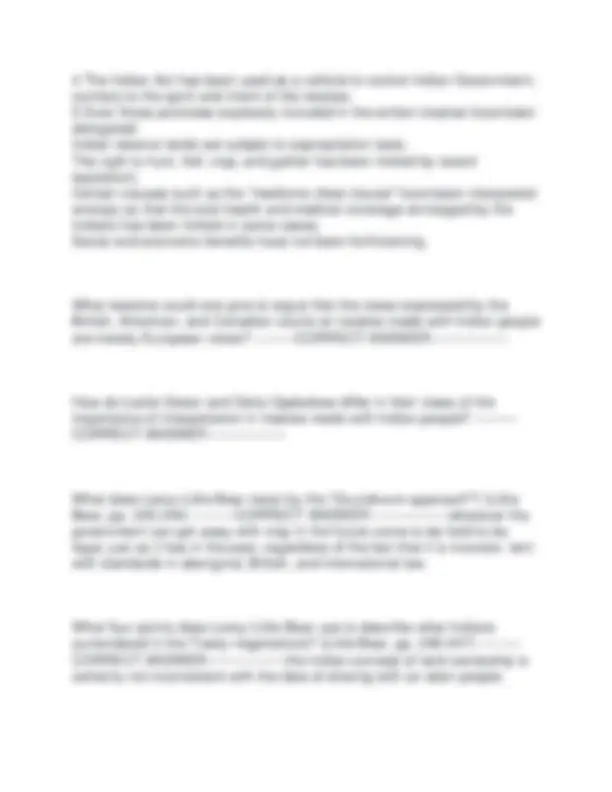
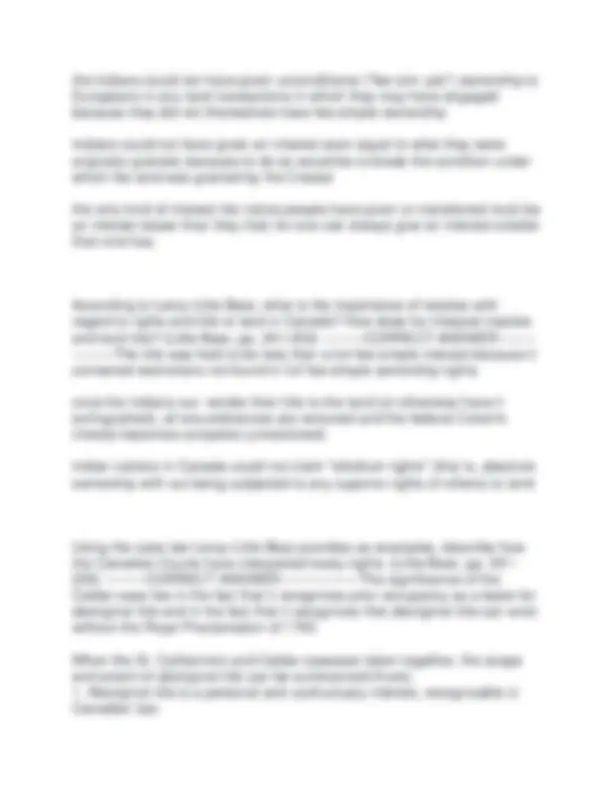
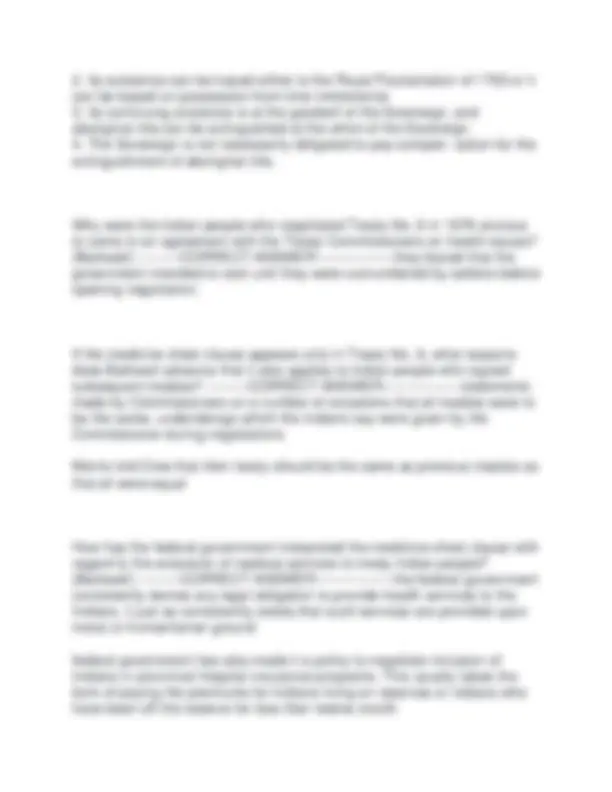
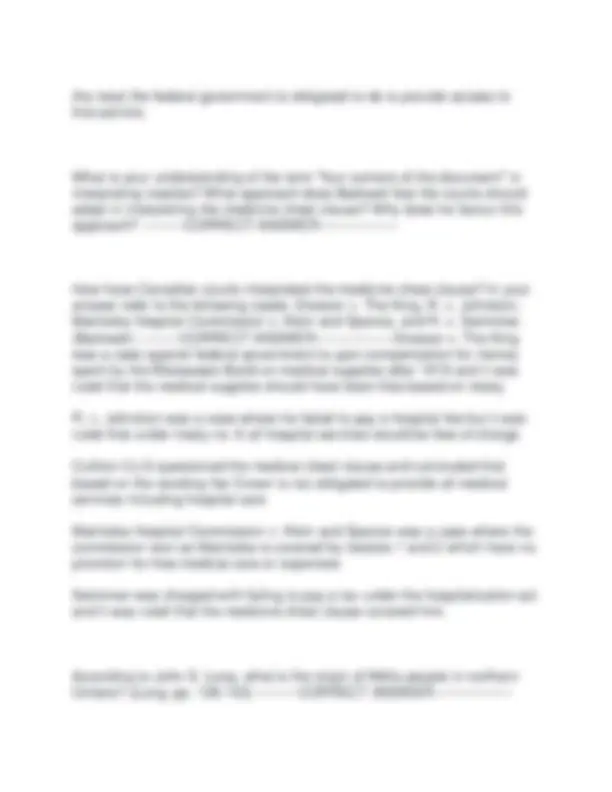
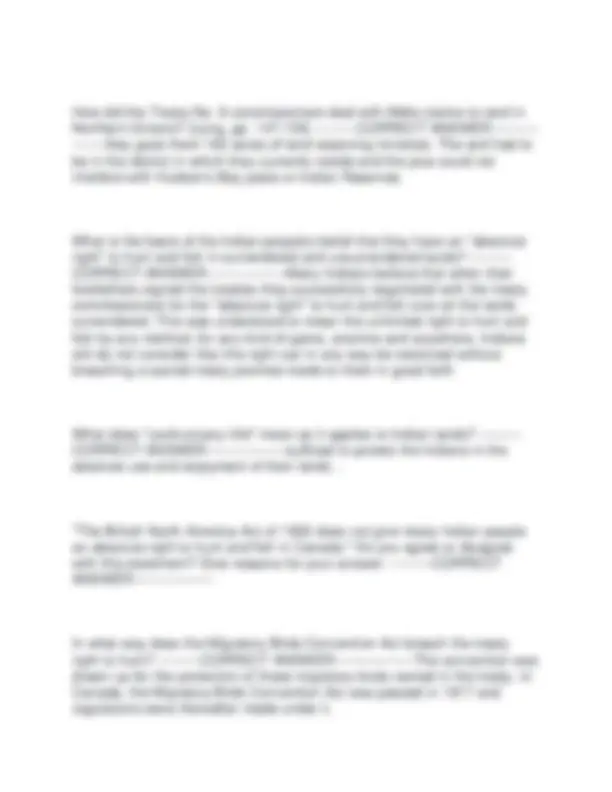
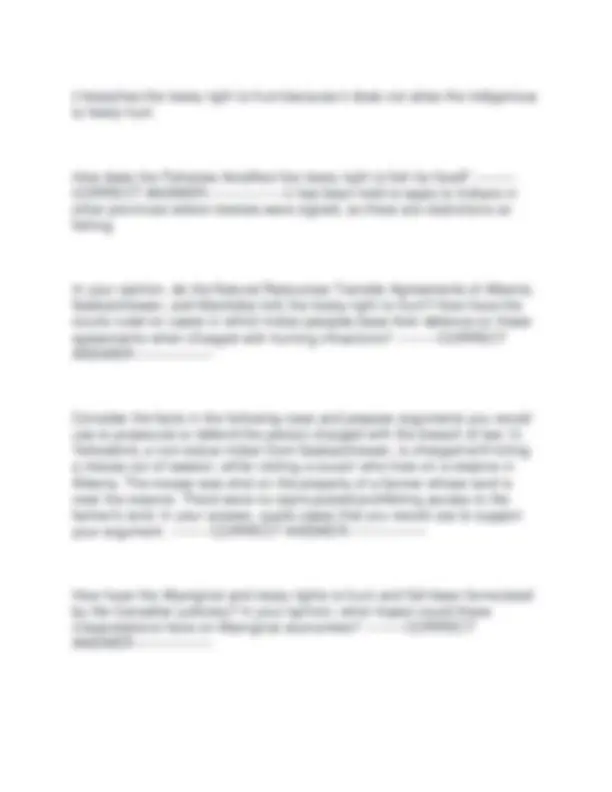
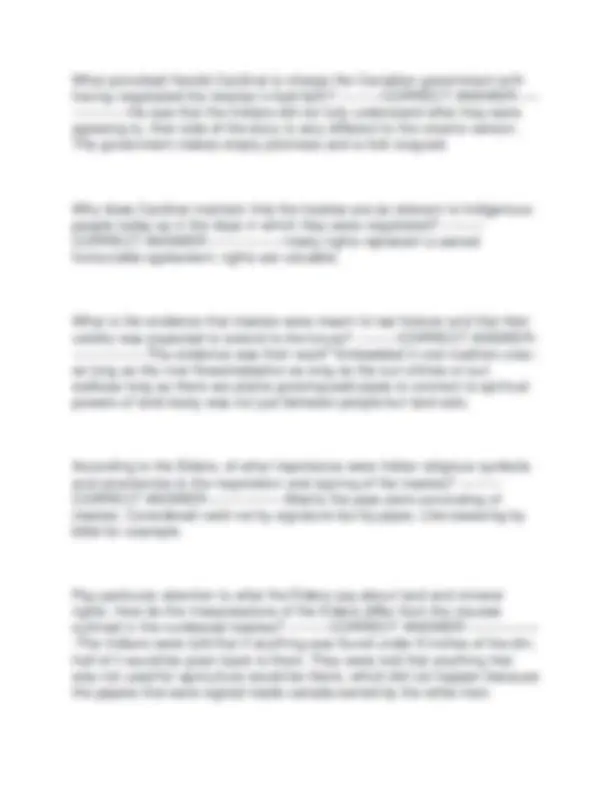
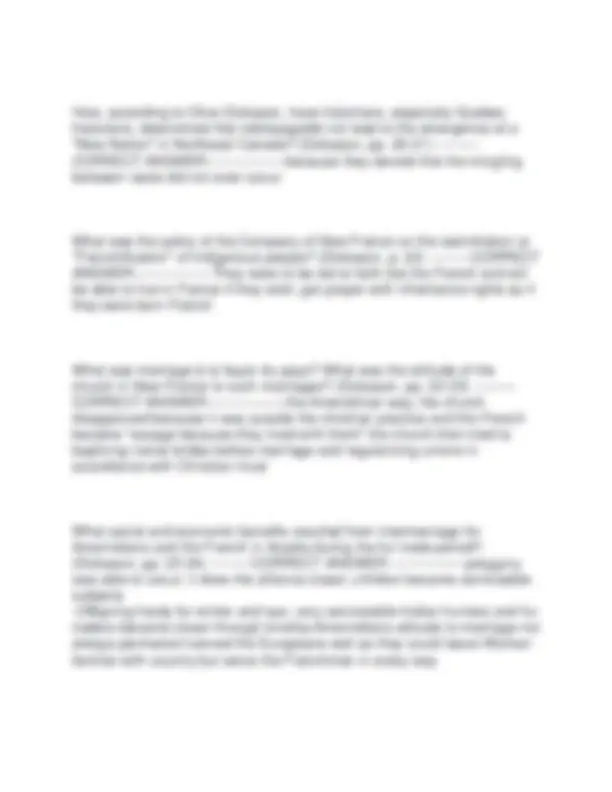
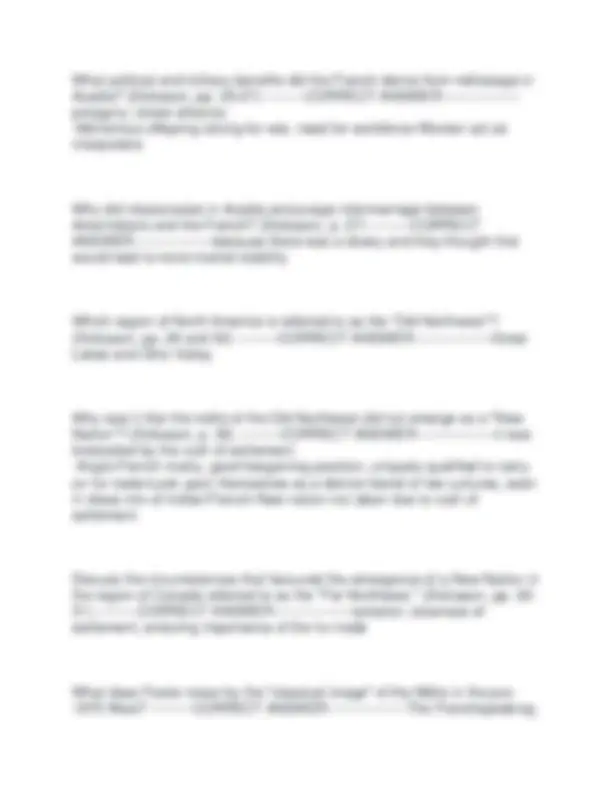
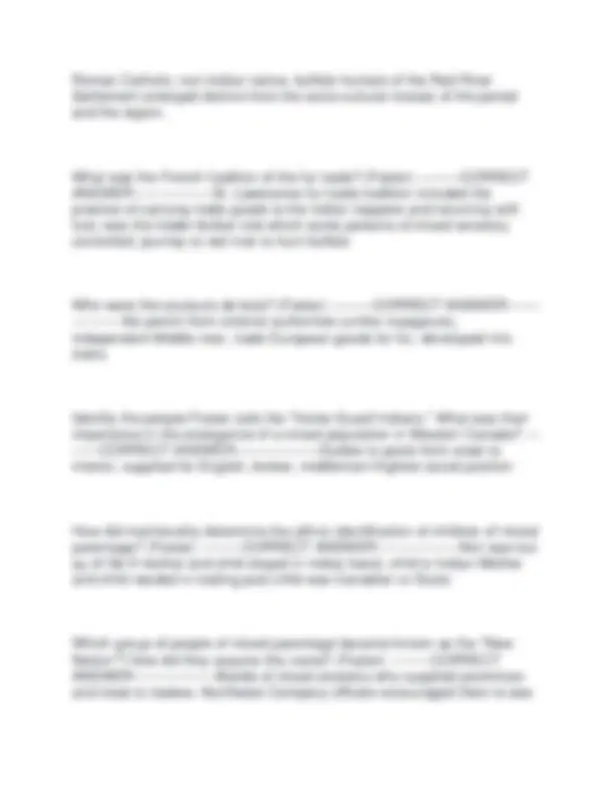
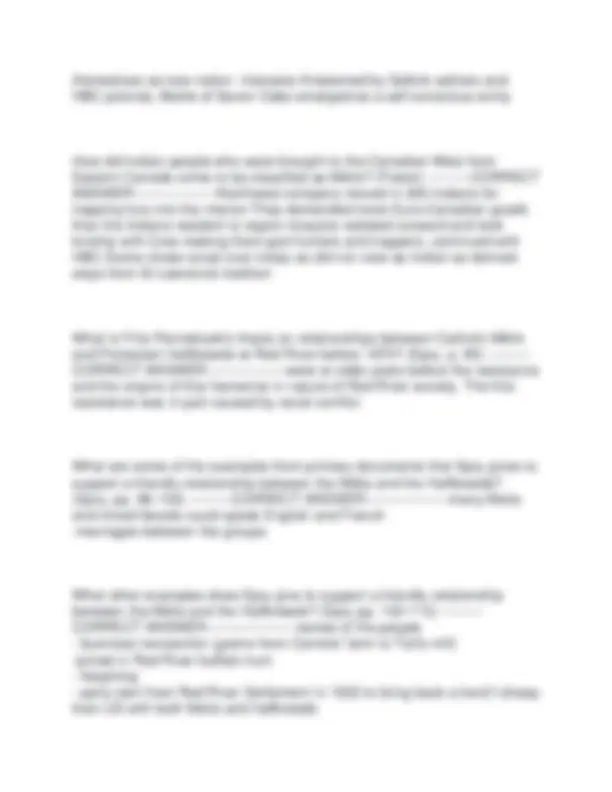
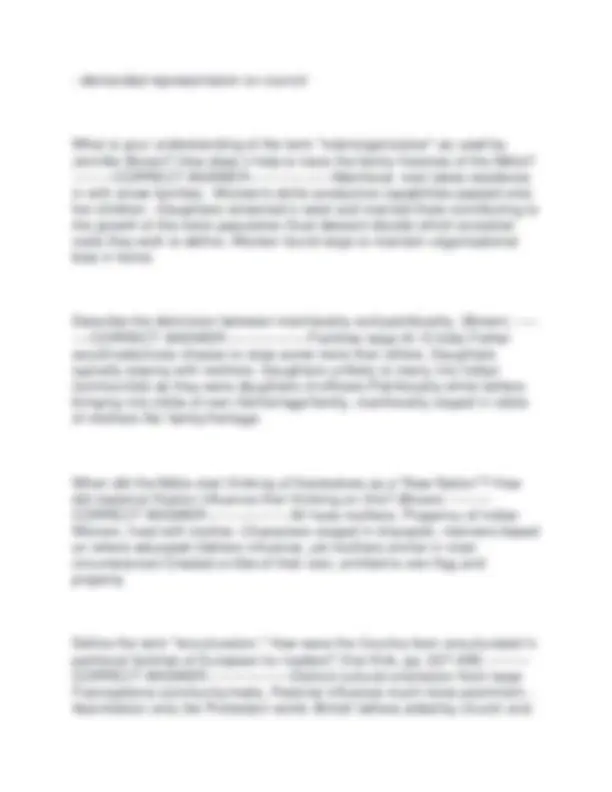
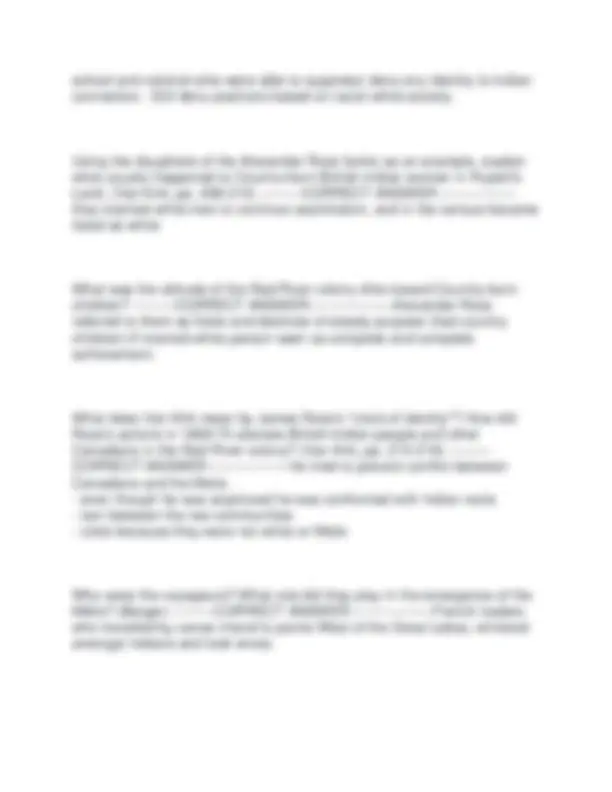
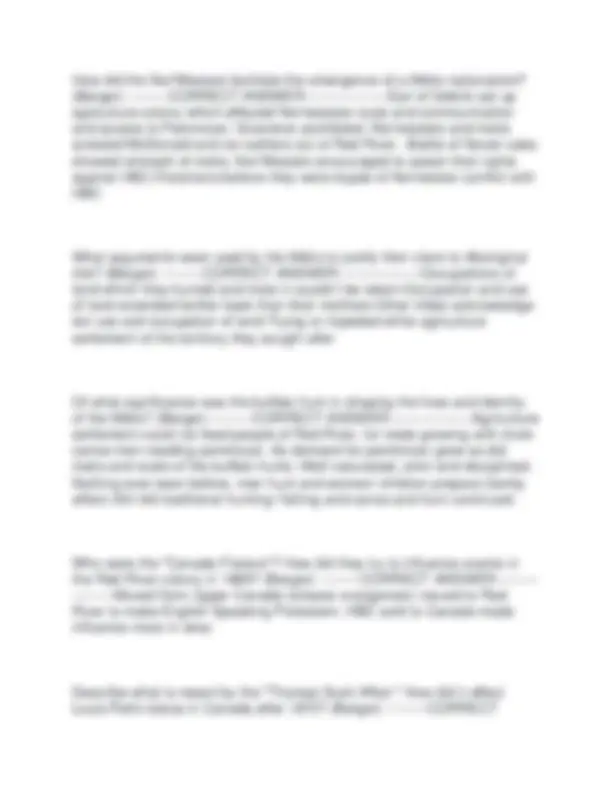
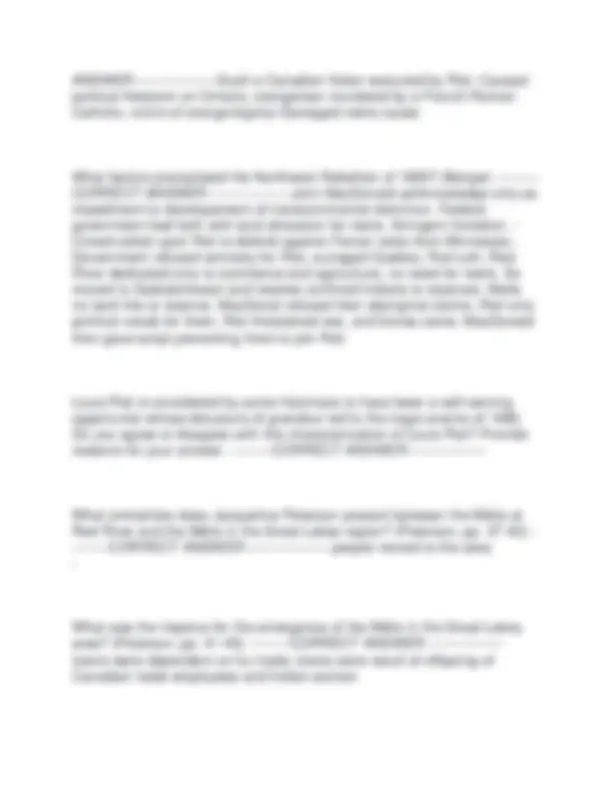
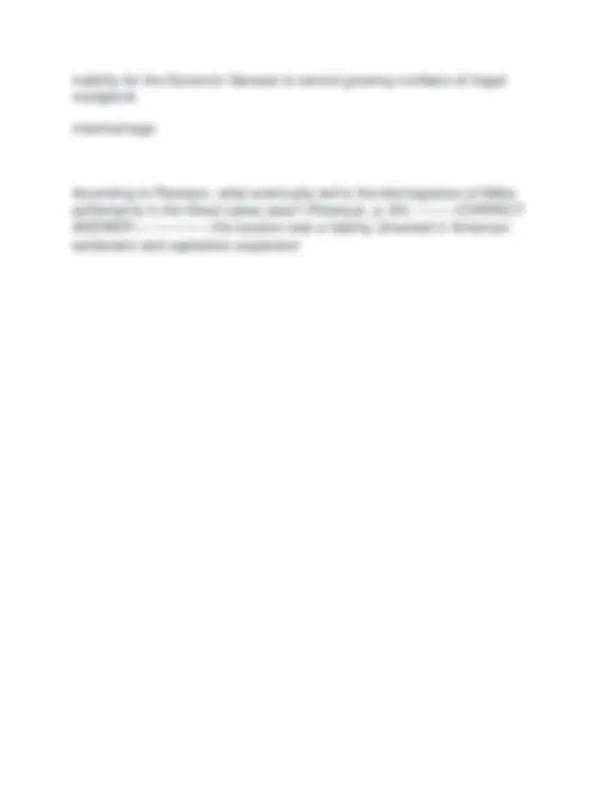


Study with the several resources on Docsity

Earn points by helping other students or get them with a premium plan


Prepare for your exams
Study with the several resources on Docsity

Earn points to download
Earn points by helping other students or get them with a premium plan
Community
Ask the community for help and clear up your study doubts
Discover the best universities in your country according to Docsity users
Free resources
Download our free guides on studying techniques, anxiety management strategies, and thesis advice from Docsity tutors
A collection of questions and answers related to indigenous history and policy in canada, focusing on topics such as treaty rights, aboriginal rights, the indian department, and the impact of colonization on indigenous communities. It offers insights into the historical context of indigenous-european relations and the challenges faced by indigenous people in canada.
Typology: Exams
1 / 35

This page cannot be seen from the preview
Don't miss anything!




























What purpose does Ponting's parallel case study of the Newfoundland Workmen's Compensation Board serve? (Ponting, pp. 98-102) --------- CORRECT ANSWER-----------------social system is transition from traditionalism to modernism; distrust is prominent; paternalistic modes of thinking What are Ponting's conclusions? (Ponting, pp. 102-109) ---------CORRECT ANSWER-----------------the Penner Committee's recommendation endorsing some Indian politicians' calls for the dissolution of DIA is too simplistic a solu- tion for at least the short to intermediate term. (1) the realization that, like many other government departments, DIA is in an intermediary position between its clientele and the larger govern- ment apparatus; (2) that DIA is under siege from both sides; and (3) that unlike many other government departments, DIA lacks both governmental support to "manage" its clientele and clientele support it should be noted that Indians in Canada constitute an enormously heterogeneous clientele compared to the clientele of most other government departments. Bands vary widely in terms of their political power and political sophistication, their geography, and the degree of need exhibited in their socio-economic circum- stances. How do treaty rights differ from Aboriginal rights? ---------CORRECT ANSWER-----------------the term "Aboriginal rights" has been used internationally to refer to the rights Indigenous people possess by virtue of being indigenous to their lands and territories
What doctrines did European powers devise to rationalize their rule over Indian people in the New World? ---------CORRECT ANSWER----------------- Doctrine of discovery declared that a European discoverer of lands previously unknown to Europeans was entitled to claim the exclusive right to acquire those lands from the indigenous inhabitants Contrast the arguments advanced by Las Casas and Sepúlveda about Indian sovereignty and title to land. ---------CORRECT ANSWER--------------- --Las Casas felt they were rational human beings who deserved respect in the same way that all human beings in the world did Sepúlveda, who argued that Aboriginal people should be regarded as inferior to European people, and that Europeans were obligated to place Aboriginal people under their guardianship, so that they could be brought to adopt European moral standards and customs Outline the main provisions of the peace and friendship treaties with respect to maintaining peace and settling disputes ---------CORRECT ANSWER-----------------to obey the English Crown and lay down their arms; to be friendly to English subjects and not associate with the French; to carry on trade with the English according to the laws of the province or the wishes of its governor; to approach the government of the province to settle disputes whenever they occurred, instead of resorting to private acts of revenge; to give three hostages to the province as a pledge of their fidelity to the treaty; to free all English captives; and to permit English subjects to enter their land unmolested Outline the main provisions of the peace and friendship treaties with respect to trading of goods in Aboriginal lands ---------CORRECT ANSWER-----------------The Aboriginal people were told not to engage in trade with European traders who were rivals of the English
What was the priority for administrators of the Indian Department in the 1840s and 1850s? (McNab, p. 86) ---------CORRECT ANSWER----------------
economic disaster, especially as supplementary opportunities for earning an income as tripmen were disappearing at the same time as the buffalo Explain briefly the origin and development of the term "Indian." --------- CORRECT ANSWER------------------ Columbus first used it because he thought he reached the east Indies
How do treaty rights affect the identity of Indigenous people in Saskatchewan? (Dyck) ---------CORRECT ANSWER------------------ registered Indians in Saskatchewan are not typical "Native people"
What arguments are advanced by those who contend that present legal identifications of Indigenous people are arbitrary and should be ended in favour of an all-inclusive Indigenous identity? (Dyck) ---------CORRECT ANSWER------------------ tends to homogenize and eviscerate historical and contemporary realities
What cultural factors make the legal distinction between "Indian" and "Métis" appear absurd and arbitrary to some Indigenous communities? (Waldram) ---------CORRECT ANSWER-----------------Hence, the cultural category "Indian" may include both those with and without legal Indian status. The "Metis" as a group may also contain non-status Indians who, in search for a more positive identity, have gravitated toward the Metis cultural group. However, while these individuals might declare themselves as "Metis," an objective examination might reveal a cultural pattern more congruent with "Indian." According to Waldram, what is a "white-status Native"? ---------CORRECT ANSWER-----------------legally-defined "nonstatus Indians," and the culturally-defined "Metis." According to Waldram, the legal distinction between Indian-status and white-status Natives leads to inequities in the delivery of government services. What inequities exist in the delivery of social assistance and economic development programs? ---------CORRECT ANSWER--------------- --treaty Indians get more social assistance; an example is the Chipewyan of northern Manitoba; separate schools were eventually constructed at the behest of estranged parents who resented the control of the opposing ethnostatus category over the education of their children; provinces such as Saskatchewan exempt status Indians from provincial sales tax, while all white-status individuals must contribute How has the legal distinction between Indian-status and white-status persons affected political developments in some Indigenous communities? (Waldram) ---------CORRECT ANSWER-----------------Band councils to represent the Indian-status people in the subarctic Native communities have been around for many years, while the development of political bodies to represent all other Natives is much more recent
What is "collective" identity? (Frideres and Gadacz) ---------CORRECT ANSWER-----------------a collective identity is how the group sees themselves (self-image) According to Frideres and Gadacz how were Aboriginal people first defined by Canada? ---------CORRECT ANSWER-----------------based on a mix of biology and culture; including the percentage of Indian blood someone had How were non-status Indians defined by the Department of Indian Affairs? (Frideres and Gadacz) ---------CORRECT ANSWER-----------------people described as having some social or biological linkage to Indians—may exhibit all the social, cultural, and racial attributes of "Indianness," they are not defined as Indians in the legal sense How did enfranchisement occur, and how could an Aboriginal person become reinstated? (Frideres and Gadacz) ---------CORRECT ANSWER---- -------------lost their Indian status through changes in the definition of an Indian, are the product of a Indian/non-Indian marriage or were dropped from Indian roll by Indian register; could have been coerced by government (ex. up until 1960 needed to give up legal status to vote) after Bill C-49 they could be reinstated by applying to be reinstated How has the official description of the Inuit person changed from 1867 to the present? (Frideres and Gadacz) ---------CORRECT ANSWER-------------- ---were considered Indians, then was based on who was given a disc number
According to Frideres and Gadacz, what are some of the divisive effects of terminology and labelling of Aboriginal people? ---------CORRECT ANSWER-----------------leads government to strategy of divide and conquer as well as assimilation; Aboriginal people begin to fight among themselves; treaty vs non-treaty receive different privileges, different amounts of money and different rights so that is very divisive What is meant by the term "enfranchisement" as applied to Indian people in Canada? Identify the legislation passed to facilitate enfranchisement of Indian people before and after Confederation. ---------CORRECT ANSWER-
What was the reaction of Indian leaders to the policy of enfranchisement? (Leslie and Maguire) ---------CORRECT ANSWER----------------- Describe particular amendments to the Indian Act aimed at eradicating Indian cultural and religious practices. (Leslie and Maguire) --------- CORRECT ANSWER----------------- Analyse the arguments advanced during the first half of the twentieth century by various politicians, government officials, and influential members of the public, and write a paragraph or two on the composite picture that Euro-Canadians had of Native peoples. (Leslie and Maguire) --------- CORRECT ANSWER----------------- How did the role of women in Iroquoian society differ from that of women in Euro-Canadian society in the nineteenth century? (Jamieson, p. 113) --------
How did Bill C-31 (An Act to Amend the Indian Act) remove discriminatory measures that had previously affected Indian women who had married out? (Jamieson, p. 128) ---------CORRECT ANSWER-----------------Eliminated enfranchisement and providing for the reinstatement of those women who lost their statutes in the past and gave power to the bands to formulate own membership codes How could previously enfranchised Indian people and their children regain their Indian status once Bill C-31 became law? (Jamieson, p. 131) --------- CORRECT ANSWER-----------------They had to apply to the Department of Indian Affairs for reinstatement to band membership and re-registration for Indians under the Indian Act. Why did some Indian bands oppose the reinstatement of Indian women who had married out to their status as band members? (Krosenbrink- Gelissen) Do you agree or disagree with the position taken by these bands? State your reasons. ---------CORRECT ANSWER-----------------To establish a national political office in Ottawa; until the existence of Indian and Aboriginal rights were fully recognized by federal government and legal guarantees were given The Native Women's Association of Canada supports the attainment of Native self-government as a political priority, but thinks that there is a fundamental prerequisite to the attainment of that objective. Discuss this prerequisite, and the position of the Association toward it. (Krosenbrink- Gelissen) ---------CORRECT ANSWER-----------------the principle of sexual equality for Aboriginal men and women must unambiguously and constitutionally stand above Aboriginal self-government. This guarantee is perceived as necessary, and unless it is implemented Indian women will still be in trouble with band councils under self-government
How does the Native Women's Association of Canada define sexual equality? (Krosenbrink-Gelissen) ---------CORRECT ANSWER----------------- removing the sex-discriminatory provisions in the Indian Act What categories of Indian people are created under Bill C-31? (Krosenbrink-Gelissen) ---------CORRECT ANSWER-----------------people who have to reinstate their Indian status; different school categories; people with fewer than two Indian grandparents The Native Women's Association of Canada was not represented at the First Ministers' constitutional conferences. How did the Association influence constitutional changes that affected the interests of Native women? (Krosenbrink-Gelissen) ---------CORRECT ANSWER----------------- lobbied to have sexual equality on the constitutional agenda; participated in other official delegations; improved relations with the Assembly of First Nations What was the nature of the roles held by Indigenous women in their societies prior to interaction with Euro-Canadian peoples? --------- CORRECT ANSWER-----------------women were highly respected with their thoughts being sought prior to decision making; woman was first person to accept peacemaker's message of peace and unity in formation of Five Nations Confederacy; defined as nourisher; keeper of culture According to the Report of the Royal Commission, what has been the enduring impact of Canadian governmental policy and legislation on Indigenous women? ---------CORRECT ANSWER-----------------issue of women not being able to control their cultural identity because it depended on husband
when people are enfranchised they are forced to assimilate to the majority population How does the "Declaration of The First Nations, 18 November, 1981" define Indigenous rights? (Jenness, p. 338) ---------CORRECT ANSWER---- -------------all rights from Royal Promclamation of October 1763; all rights recognized in treaties between the Crown and nations/tribes of Indians in Canada; all rights acquired by Aboriginal peoples in settlements of agreements with Crown How is colonialism defined in J. Rick Ponting's "Relations between Bands and the Department of Indians Affairs: A Case of Internal Colonialism?" (Ponting, pp. 85-86) ---------CORRECT ANSWER-----------------forms of manipulation or social control exercised by the DIA bureaucracy over its Indian clientele. Particularly important were socio-fiscal control (based on control over the "purse strings") and technocratically based control, which might be called neo-paternal- ism. In the study presented by Ponting, what were the criticisms against the Department of Indian Affairs concerning self-administration, economic development, and the flow of information? (Ponting, pp. 87-98) --------- CORRECT ANSWER-----------------DIA has prematurely sloughed off its administrative responsibilities onto some bands before they adequately prepared to assume those responsibilities; the alleged motivation for this is to make it likely that the bands will fail at self- administration so that (1) DIA will have to reassume responsibility; (2) other bands will be deterred from moving toward self-admin- istration and (3) the jobs of DIA staff members will be secured rather than phased out. The most widespread criticism is that DIA's economic develop- ment programs are grossly under-funded. the inadequacy of funds to hire con- sultants to do adequate advance planning predisposes many eco- nomic development projects to failure; and the department's ap- proach of merely providing "seed" (start-up) money is a "band-aid" approach that fails to
come to grips with the enormity and gravity of the need. They favour one band over others One complaint is that some bands get notice of a meeting only after the meeting has already been held, or get notice of the existence of newly available program funds only after the deadline for applying or after other bands have already been allocated all or most of the funds. DIA is also criticized for not giving bands enough lead time to be able to respond properly to some requests for information and for some- times not giving enough advance notice to enable sound proposals to be formulated How did the War of 1812 affect the bargaining position of the Indian nations of Upper Canada vis-à-vis the colonial government? (Surtees, pp. 67-70) -- -------CORRECT ANSWER-----------------more pressure to give up large sections of land but they were as vulnerable as ever as they were becoming the minority in area Why did the colonial government enter into negotiations with Indian chiefs for land surrenders? (Surtees, pp. 65-67) ---------CORRECT ANSWER------- ----------they wanted a way to provide for the military settlements and expected immigration How did the system of annual treaty money start in Upper Canada? (Surtees, pp. 69-70) ---------CORRECT ANSWER-----------------started by the British trying to figure out how to pay for land; income from interest in land auction would make annual payment to Indians who sold land; effort to save money by making a system of annuities rather than one payment In exchange for surrendering their lands, what did the Indian tribes in Upper Canada ask the colonial government to give them? (Surtees, pp. 71-73) ---- -----CORRECT ANSWER-----------------4000 pounds, blacksmith to make
According to Opekokew, the treaties confirmed certain principles and guaranteed certain rights in perpetuity. Outline and discuss five of these principles and rights. ---------CORRECT ANSWER-----------------1. The Indian nations retained sovereignty over their people, lands, and resources, both on and off the reserves, subject to some shared jurisdiction with the appropriate government bodies on the lands known as unoccupied Crown lands. This is the foundation of Indian government.
4 The Indian Act has been used as a vehicle to control Indian Government, contrary to the spirit and intent of the treaties. 5 Even those promises expressly included in the written treaties have been abrogated: Indian reserve lands are subject to expropriation laws; The right to hunt, fish, trap, and gather has been limited by recent legislation; Certain clauses such as the "medicine chest clause" have been interpreted wrongly so that the total health and medical coverage envisaged by the Indians has been limited in some cases; Social and economic benefits have not been forthcoming. What reasons could one give to argue that the views expressed by the British, American, and Canadian courts on treaties made with Indian people are merely European views? ---------CORRECT ANSWER----------------- How do Leslie Green and Delia Opekokew differ in their views of the importance of interpretation in treaties made with Indian people? --------- CORRECT ANSWER----------------- What does Leroy Little Bear mean by the "Grundnorm approach"? (Little Bear, pp. 243-244) ---------CORRECT ANSWER-----------------whatever the government can get away with may in the future come to be held to be legal, just as it has in the past, regardless of the fact that it is inconsis- tent with standards in aboriginal, British, and international law. What four points does Leroy Little Bear use to describe what Indians surrendered in the Treaty negotiations? (Little Bear, pp. 246-247) --------- CORRECT ANSWER-----------------the Indian concept of land ownership is certainly not inconsistent with the idea of sharing with an alien people.